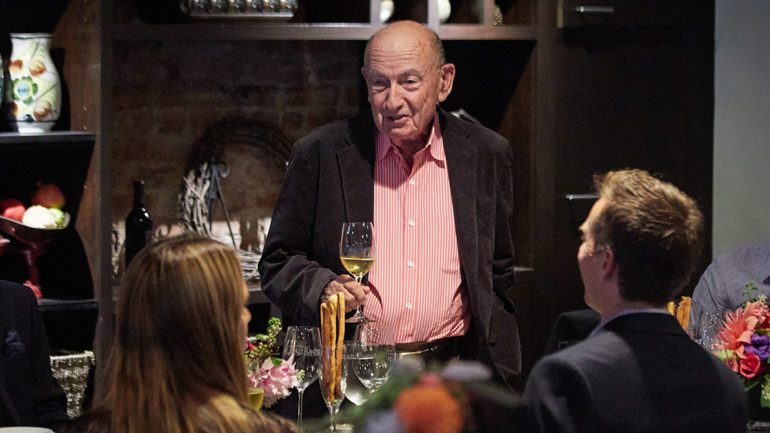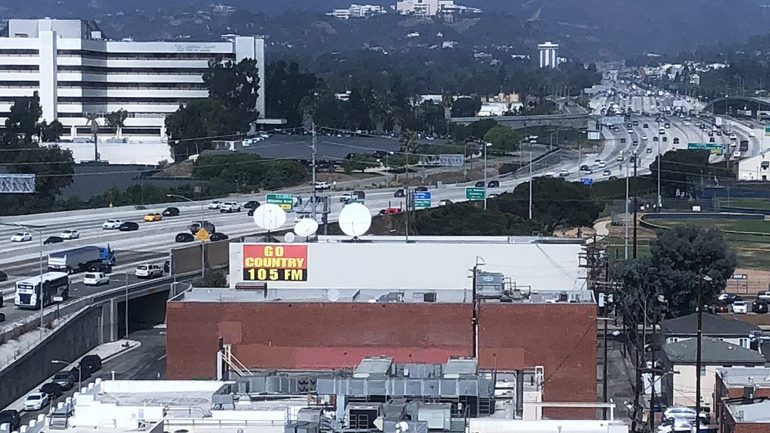Meet Go Country’s Saul Levine, Los Angeles’ Last Radio Pioneer Who’s 405-Famous
By Roy Trakin
LOS ANGELES (Variety.com) – The name Saul Levine might not ring a bell, but anyone who’s driven on the 405 between Wilshire and Santa Monica Blvd. has undoubtedly seen the billboard for his KKGO Go Country 105 radio station, which sits atop the headquarters of Mount Wilson FM Broadcasters, Inc. (named after the local peak where he built his transmitter and antenna 60 years ago).
The 92-year-old founder and owner of the company is hunched behind his desk on an otherwise unoccupied third floor of the building underneath the freeway underpass around the corner from Variety’s offices. In one of the remarkably prescient moves that mark his unlikely journey from the cow-town of Cheboygan, Michigan, to sunny Southern California, Levine purchased the land for $800,000 in 1985, knocking down a flophouse for military vets that occupied it at the time.
Levine’s company, which employs son Michael as the station’s PD, Manager, National/Local Sales and Marketing Director, and daughter Stephanie as a legal counsel who also consults KKJZ (KJazz 88.1)/Long Beach, owns FM station KKGO (105.1), the L.A. area’s only country station, as well as AM oldies outpost KSUR (1260 K-SURF). Programming the additional station opportunities represented by HD Radio (not high-definition, but “in-band on channel digital radio technology used to transmit audio and data”), Levine also programs “Unforgettable,” an Adult Standards channel (HD3) and his other passion, the classical K-MOZART (HD4), with KSUR-AM simulcast on HD2.
Levine’s parents — his father an atheist from Lithuania, his mother an Orthodox Jew from the Ukraine — were part of an arranged marriage after arriving on Ellis Island. When Levine’s father couldn’t survive hauling a pushcart through New York’s crowded lower east side, he headed west on a train, landing in the Chippewa outpost of Cheboygan, 90 miles from the Canadian border town of Sault Ste. Marie, where he opened a general store and sent for his wife to join him.
“When I was a kid, it was great,” recalls Saul. “There was outdoor ice-skating, skiing, tobogganing, We were the only Jewish family there.”
Still, the ambitious Levine vowed never to return to the town, leaving the University of Michigan after one year to enroll at UC Berkeley, where he majored in general studies, with an emphasis on philosophy, economics and psychology. “It didn’t prepare me for any kind of real job, but it was fun reading Schopenhauer and Spinoza,” he laughs. After graduation, he took a job as a social worker for the County of Los Angeles, then got his graduate degree at USC in social work before finishing law school at UCLA. All along, he harbored a desire to get into radio.
Realizing the potential of the nascent FM band — which in the late ‘50s was merely simulcasting its more popular AM station’s programming — the then-32-year-old Levine secured an FCC permit for an FM station in Los Angeles in 1958, after the original AM outlet chose not to renew its license, citing the expense of paying for electrical power.
Like Daniel-Day Lewis in “There Must Be Blood,” Levine bulldozed the land atop Mt. Wilson –which he leased from the U.S. Forest Service for $350 a year — driving the tractor himself. He acquired a transmitter from a defunct Michigan station for $1,500, had an antenna crafted out of a lead pipe, and bartered commercial time on the yet-to-air station for a $300 flag pole so they could broadcast. He even built a makeshift studio on the site itself, where an eccentric Seven-Day Adventist-turned-engineer who literally lived off the land kept the station on for as close to around the clock as humanly possible.
KBCA launched in February 1959, with a classical format, then turned to jazz in 1979 as the first incarnation of KKGO, then back to classical in 1990 when KFAC dropped the format, changing the call letters to KMZT (K-MOZART) in 2000, before finally going country as KKGO in 2007 when owner Emmis Communications pulled the plug on L.A.’s only country station at the time, KZLA.
“Where I grew up, they called it country and western music, and it was around all the time,” says Levine, who insists he still listens to every record that airs on the station. “It was only when I went to college and started dating girls that I became interested in all this high-falutin’ classical and jazz, which I’m still crazy about.
“I like the new country because it’s more like rock and you don’t get that nasal twang. But I’ve even become used to that.”
By the mid-‘90s, Levine owned an FM and two AM stations in Los Angeles, an AM, FM and TV station in Honolulu, as well as an AM and FM station in San Francisco, all of which he’s pretty much divested save for the two stations in town.
“I enjoyed that,” he admits, “It was a lot of fun, but the reality was the only stations that were making money were here, and I could run those on a day-to-day basis. It’s never the same when you let other people manage for you.”
With all the consolidation in the radio industry over the years, Levine was never tempted to sell, even when the Clear Channels of the world came calling. Always interested in technology, the radio exec recognized early on the potential of FM.
“There weren’t even any high-fidelity recordings to play at the time,” he says. “The only people broadcasting in FM were hobbyists from their bedrooms or garages. But FM was both noise and static-free, and I knew that audio would eventually catch up. And it gave me a change to own my own radio station.”
Years before SiriusXM, in 1983, to be precise, Levine was syndicating his jazz programming nationally through satellite, but recognizes the threat big-pocketed companies like that represent in the battle for the car dashboard with the traditional AM/FM hierarchy.
“Ninety percent of the population in the U.S. listens to terrestrial radio at least once a week,” insists Levine. “Radio will survive for the next 15 to 20 years. It’s free, it’s local, it’s live and it’s the only medium that deals with your community.”
Levine sees HD Radio as one way to combat the competition by providing more niche programming for a target demo. “I see an almost analogous situation with the early days of FM radio,” he says. “There’s no revenue from the classical or oldies stations, but the country format supports them all, so I don’t care.” (KKGOs registered a 2.0 share in the latest Nielsen Audio ratings.)
With the loss of his wife Anita six years ago to ovarian cancer when she was 65, Saul has turned to match.com to pursue romantic interests, confessing that he lists his age as 71 while seeking a female partner no older than 65.
“There was one I liked, but she turned out to be a little meshugge,” he says. “She was attractive and intelligent, but she’s converted to Hinduism and wanted me to also. Then I found out she was spiking my meals with herbs. She kept telling me Big Pharma’s killing us, but if it weren’t for Big Pharma, we wouldn’t be here at all.”
Aside from going to work at the office every day, Levine has also become the world’s oldest winemaker with his Cobblestone Vineyards, an award-winning company that cultivates in Monterey (Chardonnay), Napa (Cabernet) and New Zealand (Pinot Noir).
“I used to help my father make wine in the garage,” he says about growing up on a farm where they would grow vegetables and fruit. “He’d buy the Concord grapes and crush them in these giant washtubs. My mother used to hate it because it attracted all these fruit flies.”
These days, after a recent knee replacement surgery, Levine maintains a steady regimen of exercise, including the treadmill and walking a couple of miles a day, a diet of fish, vegetables and fruit, and, naturally, a glass of wine every night. Is he scared of dying?
“I used to be, but now I don’t think about it,” says Levine, who dotes on his two-year-old granddaughter and surmises he’ll be around until she hits bat-mitzvah age. What kind of wisdom does he offer at 90 years her elder? Says Levine: “I’ve been a very lucky person. Seems like everything I touched could easily have gone south, but it went north instead. I worked hard, though. I put in the time.”


